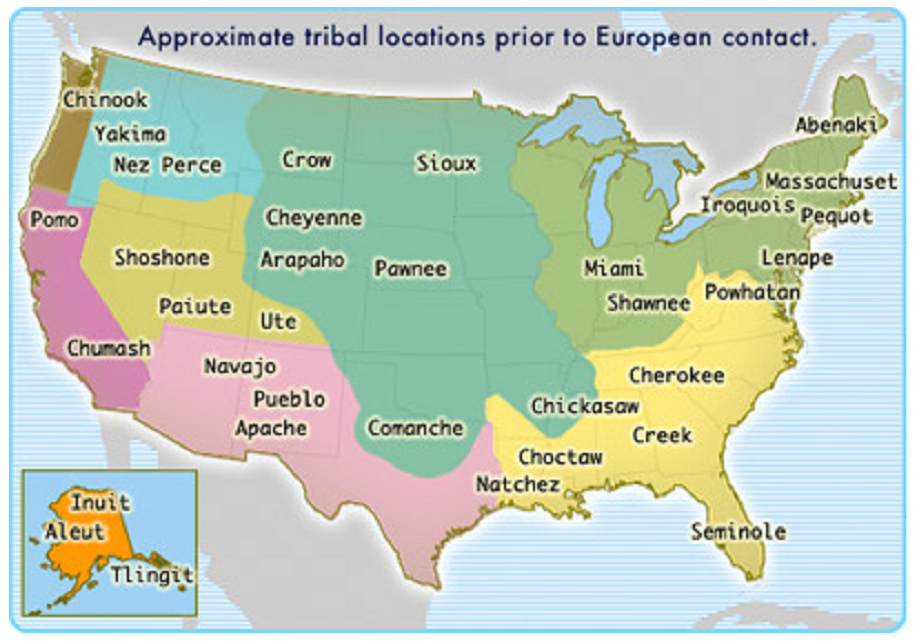from: Learner: Indians
https://web.archive.org/web/20110918062012/http://www.learner.org/interactives/historymap/indians3.html
http://www.learner.org/interactives/historymap/indians3.html
(in 2023 not online any more)
========
5. West Plateau and Great Basin Tribes and
South West tribes

5.1. West Plateau Tribes
Yakima
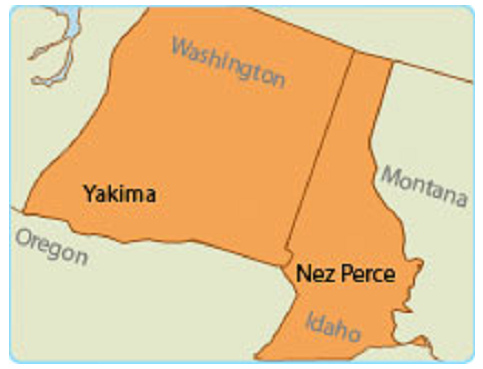
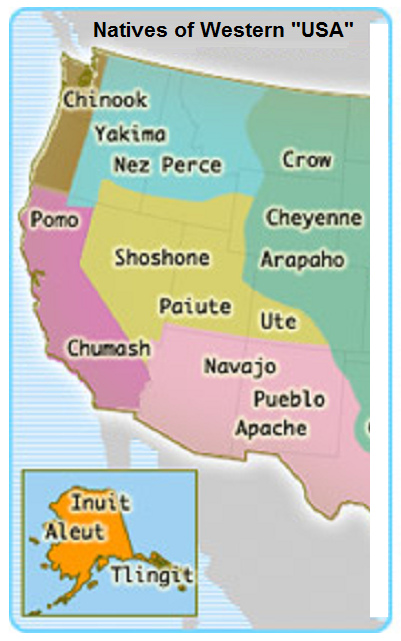
Map of West plateau ("USA") with Yakima and Nez Perce
natives [3] - map of Western natives of the "USA" [2]
The Yakima were hunter-gatherers in central Washington who
subsisted on seasonal plants, hunting, and fishing. Because of
the varied climate, the tribe lived in teepees or mat houses
during the summer months and pit houses dug into the ground
[with earth walls and earth warmth] during the winter months.
Their main forms of transportation were dugout canoes and
horses.
When the Yakima began to encounter [Jesus fantasy "Christian"]
settlers, they resisted giving up their land. They went to war
against the U.S. in 1855 when the government tried to place
the tribe onto a reservation [open air reservation camp]. The
Yakima battled until 1858, when they could no longer ward off
the settler encroachment into their territories. They were
forced to surrender and moved onto a reservation.
[So I clearly think that these criminal Jesus fantasy
"Christians" are superfluous and only damage the planet!]
========
Nez Percé
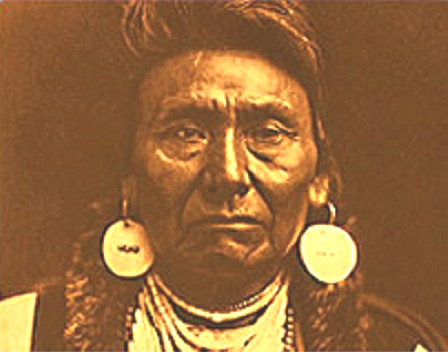

Nez Perce Leader chief Joseph [4] - map
of Western natives of the "USA" [2]
Living in Oregon, Washington, and Idaho, the Nez Percé were
noted horsemen, who supplemented their diet of salmon, plants,
and roots by hunting large game like buffalo and elk. Villages
were established along rivers or streams, and the tribe lived
in longhouses surrounding the seat lodge and village council
building.
The Nez Percé were first encountered by Lewis and Clark on
their expedition in 1805. The tribe helped Lewis and Clark in
their exploration of the Northwest Territory. As white
settlement of the northwest [with criminal Jesus fantasy
"Christians"] grew, the Nez Percé began to come into conflict
with settlers. In 1863, a treaty with the U.S. severely
reduced their lands, but some members of the tribe, led by
Chief Joseph, refused to relocate. This led to the Nez Percé
War of 1877. The tribe was defeated by the U.S. Army and
forced onto a reservation in Washington.
[So for this criminal behavior of the Jesus fantasy
"Christians" as guest on a foreign continent there is really
only one answer: stake!]
========
5.2. Great Basin Tribes
Shoshone
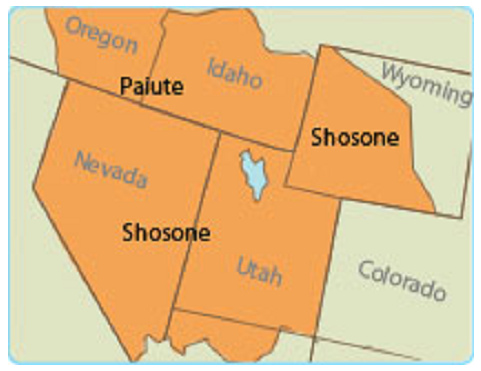

Map with natives in the Great Basin ("USA"): Palute and
Shoshone natives [5] - map of Western natives of the "USA"
[2]
The Shoshone comprised three main groups:
-- the Northern, who used horses, inhabiting [today's] Utah
and Idaho;
-- the Western, who did not use horses, living in [today's]
Nevada; and
-- the Eastern or Wind River, living in [today's] Wyoming.
First encountered by Lewis and Clark in 1805, the Shoshone
managed to barely survive as hunter gatherers in varied,
difficult terrain and climates [winters with minus 20ºC or
even colder]. They traveled, seasonally harvesting plants and
hunting for animals.
Sacagawea, a Shoshone woman, assisted Lewis and Clark as they
explored the difficult, mountainous terrain in Shoshone
territory. As settlers began to occupy Shoshone lands in the
1860s, more and more conflicts arose as the groups fought over
meager resources. The Shoshone were forcibly removed from
their lands to a reservation [open air concentration camp] in
1905.
[Deportation! That did the criminal Jesus-fantasy-"Christians"
also with Jews, with Indians, with South Africans, with Poles,
with German-Russians etc. etc. etc.. These criminal
"Christians" must be locked away and then peace will come with
Mother Earth].
========
Paiute
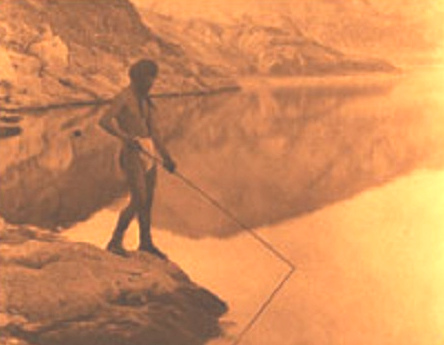

Paiute native is fishing [6] - map of Western natives of the
"USA" [2]
The Paiute's great expanse of territory included parts of
Oregon, Utah, Nevada, Arizona, and California. Much of their
land had a harsh, desert climate, so in order to survive, the
Paiute lived in small villages centered around lakes or
wetlands well supplied with fish and wildlife. As
hunter-gatherers, they harvested seasonal, native plants and
hunted rabbits and pronghorn. The Paiute's homes were
temporary brush shelters, which made it easy to move from
place to place to follow game and food supplies.
The Paiute had little contact with Europeans until the 1840s.
As settlers came into their region, they brought with them new
diseases and guns, and also stretched the area's meager food
resources. The 1860s Gold Rush and white [Jesus fantasy
"Christian" criminal] settlement of land in the newly opened
territories created conflicts with the tribe. Most frequently,
[the criminal Jesus fantasy "christian"] settlers would raid
Paiute villages or harm tribe members in their quest for land,
food, or other resources. After battling [the criminal Jesus
fantasy "Christian"] settlers unsuccessfully, the Paiute were
removed from their territory by the [criminal Jesus fantasy
"Christian"] U.S. government in 1874.
Addition: Ghost dance against the criminal Jesus fantasy
"Christians"
The Mossad Wikipedia describes how the indigenous Paiute
people wished intensively that these criminal Jesus fantasy
tourists would finally disappear: Quote (translation with Bing
translator):
"Ghost Dance Movement
Around 1870, the ghost dance arose in the settlement area of
the Paiute, which, according to the religious convictions of
the tribes, predicted the disappearance of the white settlers.
Under the Paiutian seer Wovoka, the ghost dance movement
reached all the tribes of the Plains around 1890 and
strengthened towards the belief that the bison and the slain
warriors were returning and that the warriors of the tribes
were invulnerable. The increasing fear of this movement
culminated in the massacre at Wounded Knee [war crime of the
criminal "Christians"] of the Lakota Sioux, which finally
broke the resistance of the Indians to the displacement. [5]
Reservation time (open air concentration camp)
The first reservation established for the Northern Paiute was
the ["Misfortune Reservation"] Malheur Reservation in Oregon.
There, according to the will of the American government, the
various Paiute were to be brought together. However, the
Paiute could not be persuaded to move, or left the reserve
quickly due to the poor living conditions. Instead, they tried
to preserve their traditional way of life or founded small
Indian colonies within white-inhabited areas where they sought
work. Later, larger reservations were established in Pyramid
Lake [6] and Duck Valley, but by this time the small
settlements were already filled up, also due to the influx of
Shoshones, and were recognized by the government as
independent tribes under the Indian Reorganization Act of
1934. There are more Northern Paiute Reservations for the
Fallon Paiute-Shoshone Tribe [7] and the Confederated Tribes
of Warm Springs Indians. [8]"
========
Ute
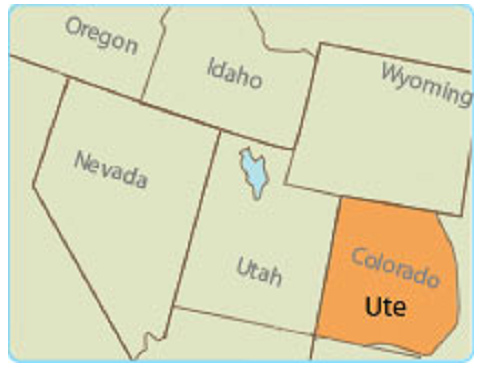

Map with the Ute natives [7] - map of Western natives of the
"USA" [2]
Hunter-gatherers, the Ute lived in Colorado and Utah. They
hunted a variety of game and gathered seasonal plants. The Ute
often celebrated and participated in religious ceremonies
centered on elements of nature. They were environmentally
responsible, not over-hunting or taking more from the land
than they needed for survival.
When the Spanish brought horses to the Ute, their lifestyle
changed since the animals allowed them more mobility. As
Mormon settlers [Jesus fantasy "Christians"] moved into their
area, they introduced the tribe to farming. Over time, the
Utes turned to raiding white settlements and trading with
settlers as a way of life. After a number of conflicts with
settlers, the U.S. government forcibly removed the Ute from
their territory and placed them on a reservation [open air
concentration camp] in 1869.
[So this criminal-"Christian" Jesus-fantasy government of the
"USA" really must go to a reservation for stopping damaging
the world!]
========
5.3. Southwest Tribes
Navajo
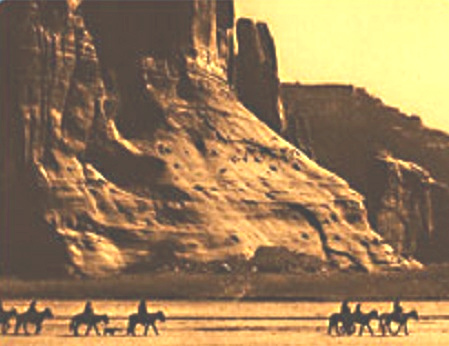

Natives in the Gorge of Chelly (Cañon de Chelly) in
northeastern Arizona [8] - map of Western natives of the
"USA" [2]
One of the largest tribes in Arizona and New Mexico, the
Navajo farmed (beans, corn, and squash [the golden three]),
hunted (deer, elk, and antelope), and gathered wild
vegetables. They lived in small villages in homes made from
wooden sticks, tree bark, and mud, called hogans. [Mud
houses insulate the interior from the heat]. The Navajo
became well known for their weaving and pottery, which they
learned from neighboring tribes.
The tribe came into contact with Spanish settlers in the early
1600s [who came from Mexico or Texas which was Spanish in
those days]. The Navajo raided the settlers' livestock,
acquiring horses, sheep, and goats. These animals greatly
improved life for the Navajo because they could be used for
travel, clothing, food, and as trade goods. As more settlers
moved into their territory in the mid-1840s, tensions
increased as the Navajo continued to raid settlements. The
conflict escalated during the 1860s and the U.S. government
held 9,000 Navajos captive at Fort Sumner, New Mexico. The
Navajo were released in 1868, but had signed treaties giving
up their land and were relocated to a reservation [open air
concentration camp].
[This is a clear "Christian" tactic: launch an invasion - get
attacked - and then steal the land from the natives as a
punishment. "Christians" are criminals WITHOUT end with the
tactics simulating always to be the "right winner". Off to the
reservation with them].
========
Pueblo
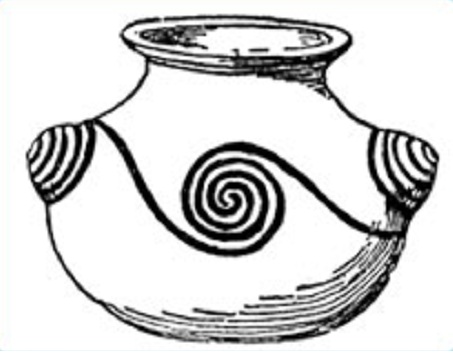

"USA" Pueblo natives, drawing of a Pueblo jar [9] - map of
Western natives of the "USA" [2]
The Pueblo live in the harsh climate of Arizona and New
Mexico, establishing permanent apartment-like dwellings made
of stone and adobe. They were built in terraced stories with
access through a trap door on the roof to protect them from
enemies. Agriculturally based, these farmers grew corn,
cotton, and melons in irrigated fields near river bottoms.
They also hunted deer, antelope, and rabbits and occasionally
ventured on large hunting parties in search of buffalo. Each
village was self-governing, run by a chief. The Pueblo were
known for their outstanding skills in making pottery and
baskets and also for using native materials to weave cloth and
clothing.
The Spanish were the first Europeans to encounter the Pueblo
in the 16th century. The Pueblo tried to resist [the Jesus
fantasy "Christian"] Spanish encroachment on their territory,
but were unsuccessful. In 1598, the [Jesus fantasy "Christian"
criminal] Spanish began establishing [Jesus fantasy] missions
in Pueblo villages in order to convert them to [Jesus fantasy]
Christianity. Although several thousand did convert, Pueblos
were able to keep their traditional culture intact while
living under Spanish rule and overthrew Spanish control in
1680. In 1692, the Spanish reconquered the tribe.
========
Apache
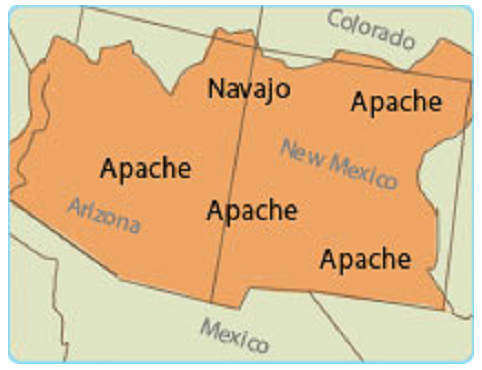

Map with Navajo and Apache natives [10] - map of Western
natives of the "USA" [2]
Forced into the desert southwest of New Mexico and Arizona,
this nomadic tribe survived by following wild game, hunting
mainly buffalo and deer, and gathering wild fruits. They used
dogs, and later horses, as pack animals and lived in buffalo
or deerskin [leather] teepees or wickiups — short,
rounded huts made of twigs and mud — which could be moved
easily and quickly.
Known for being physically tough, the Apache were forced into
becoming fierce fighters as Europeans advanced into their
lands. The Apache turned to raiding in order to survive when
New Mexico became a Spanish colony. With colonists using
Apache resources, stealing goods and livestock and reselling
it became the tribe's only means for survival. The Apaches
fought bitterly for their land and were defeated by the U.S.
military in the Indian Wars of 1848. Upon defeat, the Apaches
were forced into reservations [open air concentrations camps].
[And again a culture was destroyed. So, it is clear, the
criminal Jesus fantasy "Christians" must go to the
reservation, so that the planet will be saved from these
criminal "Christian" wild animals with 2 legs].
Photo sources
[1,2,3,4,5,6,7,8,9,10]
from: Learner: Indians
https://web.archive.org/web/20110918062012/http://www.learner.org/interactives/historymap/indians3.html
http://www.learner.org/interactives/historymap/indians3.html
(in 2023 not online any more)
^


